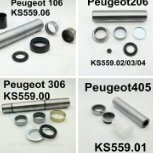-
Welcome to Auto Parts Forum
Whether you are a veteran automotive parts guru or just someone looking for some quick auto parts advice, register today and start a new topic in our forum. Registration is free and you can even sign up with social network platforms such as Facebook, X, and LinkedIn.
Should I replace front and rear brakes at the same time?
-
Similar Content
-
- 0 replies
- 124 views
-
Toyota Corolla Front & Rear Brake Pads
By garryhe,
- toyotabrakepads
- toyotacorollabrakepads
- (and 2 more)
- 0 comments
- 0 views
-
- 0 replies
- 641 views
-
- 0 comments
- 0 views
-
The Best Front And Rear Brake Pads For Cars, Trucks & Suvs
By garryhe,
- ketullabrakes
- frontbrakepads
- (and 1 more)
- 0 replies
- 394 views
-
-
Similar Topics
-
By austinbearing
Hello, everyone.We are an auto bearing manufacturer from China.
We produce Peugeot, Renault, Fiat and some other aut bearings.
Contact me if you're interested.
WhatsApp: +8613775640157
E-mail: [email protected]
-
By Mia
Regular inspection and maintenance of the brake system not only ensure the safety and reliability of the vehicle but also effectively extend the lifespan of the brake system, improve brake performance, and guarantee driving safety.
The components of the brake system include the brake pedal, booster, master cylinder, brake lines, wheel cylinders or brake calipers, and friction materials. Common brake systems include disc brakes and drum brakes. KETULLA specializes in manufacturing disc brake pads.
We know that brake pads are crucial consumables in the brake system, and timely replacement is essential to maintain brake performance. Whether it’s wet, slippery, or snowy road conditions, contaminated friction materials, aging system components, or corrosion of components, regular inspection and timely replacement of brake pads are indispensable parts of brake maintenance.
Choosing high-quality replacement parts and using certified products and services not only enhance the performance of the brake system but also ensure driving safety.
Timely replacement of brake pads is crucial. Typically, brake pads are equipped with accessories such as brake pad wear indicators or sensors. Different vehicle models are matched with different brake pad warning devices; some use indicators, while others can be connected to the vehicle’s warning line. Once the brake pads wear to a certain extent, the warning line is triggered, emitting a squeaking sound to indicate the need for replacement because continuing to use worn brake pads is no longer safe.
The distance a vehicle can travel after the brake pad warning is activated varies depending on individual driving habits and conditions. Continuing to use worn brake pads may wear down the brake rotor, leading to brake rotor damage, and necessitating the replacement of both brake pads and rotors, which can be costly.
When should brake pads be replaced?
Brake pads generally need to be replaced after the vehicle has traveled approximately 60,000 kilometers. However, the warranty for KETULLA brake pads ranges from 30,000 to 50,000 kilometers, depending on driving habits and road conditions.
When the thickness of the brake pads approaches or falls below 0.3 centimeters, it’s time to replace them. If you hear friction noises when lightly pressing the brakes, immediate replacement is necessary. When the friction material thickness decreases to 8 millimeters, it’s advisable to inspect and possibly replace the brake pads. When the pad and steel plate thickness decreases to 3 millimeters, immediate replacement is recommended to avoid safety hazards.
The lifespan of brake pads typically falls between 30,000 to 50,000 kilometers, depending on driving habits and conditions. Warning signs for brake pad replacement include decreased braking performance, increased braking distances, and abnormal noises. Regular inspections are necessary to determine when brake pads need replacement.
New brake pads usually have a thickness of approximately 1 centimeter, with a usable limit of 3 millimeters. If brake pads are excessively worn, contaminated with oil, or show signs of abnormal wear or tearing, they should be replaced immediately. It’s essential to regularly check brake pad wear and replace them as needed. Replacement intervals may vary depending on the type of brake pads and driving conditions.
Regularly inspect the thickness of brake pads, and if worn to at least 1/4 inch, it’s time for replacement. The lifespan of brake pads depends on various factors, including driving style, vehicle type, and load conditions. Regular inspections are necessary to determine when replacement is needed.
This article explains more details:
link hidden, please login to view -
By Counterman
link hidden, please login to view announced a new addition to its Galvanized Brake Pad lineup. The new part introduction covers over 630,000 vehicles on the road, the company said. The company added that the brake pads are built using
link hidden, please login to viewGalvanized steel and incorporate O.E. specified Mechanical Fusion Technology. link hidden, please login to view New Part Number(s) & Vehicle Compatibility: NS2304
Expanded coverage includes the following vehicle models: Lexus: RX350 (2023), RX350H (2023-2025); Toyota: Highlander (2020 – 2024), Grand Highlander (2024-2025).
The post
link hidden, please login to view appeared first on link hidden, please login to view.
link hidden, please login to view -
By jazroot84
You should consider us if you are looking for an link hidden, please login to view. After receiving your orders online with the requisite details ( make and model with manufacturing year), we can check inventories in the area's junkyards. Additionally, our junkyards are located to find the suitable airbags and the right type and numbers per your order. The fascinating thing is that you'll get this at half the price for the new module.
For more information please contact us at +1-609-951-9801.
-
By AutoZone
MEMPHIS, Tenn. , May 21, 2024 (GLOBE NEWSWIRE) -- AutoZone, Inc. (NYSE: AZO) today reported net sales of $4.2 billion for its third quarter (12 weeks) ended May 4, 2024 , an increase of 3.5% from the third quarter of fiscal 2023 (12 weeks). Same store sales, or sales for our domestic and
link hidden, please login to view
-





Recommended Posts
Join the conversation
You can post now and register later. If you have an account, sign in now to post with your account.
Note: Your post will require moderator approval before it will be visible.